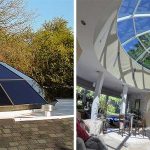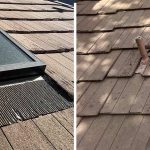We’ve been blessed with a generous amount of snow these past few days. How does this effect our roofs and skylights?
At the time of this writing we are still receiving white flakes from the sky and have been for the last two days. We have snow totals of about three feet! What is interesting for those that don’t get this kind of experience is that the snow started out heavy and wet but has ended up white and fluffy. So if you want to shovel your sidewalks you’ll find a wet slushy snow underneath a couple of feet of light, powdery snow.
This is the same snow that causes so many problems with leaking skylights. What happens is this wet, slushy snow contains a high amount of water that sits at the top of the skylight at the roof level and is held in place by the snow itself. Then when the temperature drops at night the water freezes and expands upward. If a skylight is not flashed properly this upward movement of moisture can reach farther than the flashing, allowing water to penetrate into the interior spaces.
We typically see this type of action in the spring when we receive the most wet, heavy snows. However, it can happen in the fall, too. What is a little unusual with this particular storm is getting white fluffy powder on top of the heavy, wet snow. It is an interesting mix and we’ll see how it acts on these Denver roofs.





